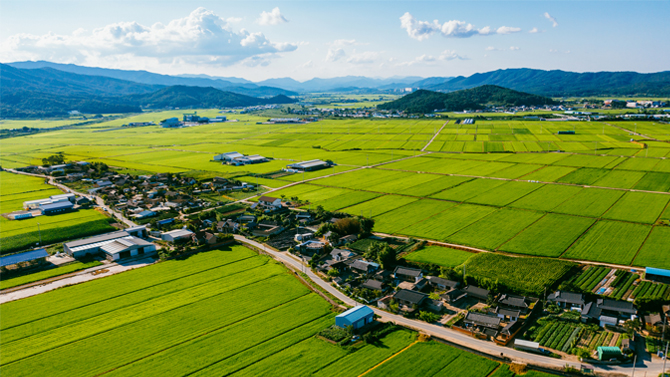Following Japan’s declaration of its intention to achieve carbon neutrality by 2050, decarbonization initiatives have gained momentum. Meanwhile, the COVID-19 pandemic has led to heightened consciousness throughout society of the vital importance of health. And there is growing awareness of the need to secure human rights throughout supply chains. There are among the pressing issues confronting all of us. We will show you what Sumitomo Group companies are doing to tackle these social issues in the course of their business activities.
Click a social issue for an explanation of the issue and articles on what Sumitomo Group companies are doing to tackle it.

Among greenhouse gas (GHG) emissions implicated in global warming, carbon dioxide (CO2) emissions are a major culprit. Hence the importance of initiatives to reduce CO2 emissions in the drive to achieve net zero GHG emissions, i.e., carbon neutrality. In order to limit the global average temperature increase and achieve net zero GHG emissions in the second half of the 21st century, which are among the goals of the Paris Agreement, the Japanese government set a target of a 26% reduction in GHG emissions by 2030 compared with 2013. In October 2020, the then-prime minister declared that Japan intends to achieve carbon neutrality by 2050. At the Leaders Summit on Climate, hosted by the U.S. in April 2021, Japan declared its target of a 46% reduction in GHG emissions by 2030 compared with 2013.

Workstyle reform is an idea that has been around for a while, but it is now coming into its own as companies introduce systems that make it possible for diverse people to work in styles attuned to their needs while enhancing productivity through creative utilization of ICT. For Japan, the challenge posed by population aging coupled with a low birthrate is particularly acute. Achieving flexible workstyles is a precondition for securing ample human resources as the working-age population continues to shrink. In addition, teleworking has become widespread, taking root amid the COVID-19 pandemic as a workstyle synonymous with the new normal.

Management of employee health plays a vital role in reducing the incidence of accidents attributable to such factors as overwork and stress while also contributing to workforce retention in the current era in which companies struggle to secure human resources. A healthy workforce is advantageous in terms of operational productivity, which ultimately translates into higher corporate earnings and growth in corporate value. In companies committed to health & productivity management, employees are more motivated and experience greater job satisfaction. The COVID-19 pandemic has brought the critical importance of prioritizing employee health into sharp focus.

A supply chain is the entire system for producing and delivering products and services from the sourcing of raw materials through to delivery to end-users. Since the weight accorded ESG (environmental, social, and governance) initiatives in the assessment of corporate value is large and growing, companies are coming under increasing pressure to respond to various issues throughout their supply chains, which include their subsidiaries and affiliates as well as their suppliers of raw materials and other items. The issues related to supply chain are diverse. They include not only environmental impacts, such as emissions of CO2, discharge of sewage, emissions of harmful substances, destruction of forests, and pollution of the oceans, but also human rights and suppliers’ workplace environments, corporate governance, and so on. If a company fails to handle these supply chain issues appropriately and neglects information disclosure, its business will likely suffer.

Countermeasures for global warming, the phenomenon driving climate change, center on the reduction of greenhouse gas (GHG) emissions and management to prevent disasters or mitigate their impacts. The Paris Agreement, adopted at the 21st Session of the Conference of the Parties to the United Nations Framework Convention on Climate Change (COP21) in 2015, following the Kyoto Protocol, reaffirmed the goal of limiting the global temperature increase to well below 2oC while pursuing efforts to limit the increase to 1.5oC compared to pre-industrial levels. Accelerating global warming is implicated in extreme weather events that pose serious risks for companies. Accordingly, companies need to formulate strategies and implement specific countermeasures from a medium to long-term perspective.

As the automotive industry undergoes a once-in-a-century paradigm shift, “CASE”, a handy acronym referring to the key aspects of this transformation—“Connected,” “Autonomous,” “Shared & Services,” and “Electric”—is the future. Not only the automotive industry but also a host of other industries interconnected with it are addressing CASE. Electrification is a powerful global trend as conventional automobiles powered by CO2-emitting internal combustion engines are increasingly replaced by electric vehicles (EVs).

At the micro level, society is composed of individuals, families and households. At the macro level one finds the national government, municipalities and so forth. In between are communities that fulfill essential roles. It is in thriving communities that mutual support flourishes, opinions are coordinated, and cultural traditions endure. Since communities are the glue that holds society together, it is in everyone’s interest to make them flourish. A community is essentially a group of people, and loss of community cohesion leads directly to a dysfunctional society where people are disconnected from one another, alone and vulnerable. Therefore, social issues cannot be tackled effectively without revitalizing communities and the interpersonal relationships that bind them together.

We live in a world where one in ten people subsist below the extreme poverty line of 1.9 dollars a day, and so it is fitting that “No Poverty” is Goal 1, topping the list of the Sustainable Development Goals (SDGs). The elimination of poverty is a truly global theme, by no means limited to developing countries. Extreme poverty, mainly seen in developing countries, is a condition characterized by severe deprivation of basic human needs, including food, safe drinking water, sanitation facilities, health, shelter, education and information. On the other hand, relative poverty, evident in developed countries, means low income relative to others. In Japan, many households, particularly those headed by a single mother, are in relative poverty. According to a 2018 survey by the Ministry of Health, Labour and Welfare, one in seven people in Japan live in relative poverty, with less than half of the median disposable income.

In view of the continuing decline of Japan’s working age population, due to population aging coupled with a low birthrate, development of the next generation is an urgent issue that should be tackled by society as whole, with the private sector playing a prominent role. Both quantitatively and qualitatively, companies need to foster human resources capable of securing future prosperity while also ensuring that the country’s precious inheritance of technology and knowhow is handed down intact to the next generation. From the “Community” perspective, the fostering of people endowed with the qualities and skills necessary to exercise effective leadership in their communities is another important theme.

Thanks to the progress of technology and the advent of ever-more sophisticated medical equipment, it has become possible to cure diseases and treat injuries that once defied the best efforts of medical science, thereby not only saving more lives but also achieving early detection of diseases and improved diagnostic accuracy. Medical care that supports patients’ quality of life (QOL) is also advancing. For example, robot-assisted surgery and PET/CT scans that can diagnose cancer anywhere in the body are making dramatic leaps forward. Such progress in medicine is largely due to the efforts of not only universities and other research institutions but also of companies to develop cutting-edge technologies.

Local production for local consumption, which means consuming local products within the region where they are produced, is attracting attention as a form of resource utilization that creates a sustainable cycle. Consuming locally produced crops within the region where they are grown eliminates the need for long-distance transportation, thus reducing CO2 emissions. In addition, the development of local communities helps realize “sustainable cities and communities,” which is one of the Sustainable Development Goals (SDGs), leading to healthier and more vibrant lifestyles. Local production for local consumption is also a way of breathing new life into regions where population aging with a declining birthrate is sapping vitality and populations are declining. Recently, with an eye to regional revitalization combined with decarbonization, there are numerous initiatives promoting industries fueled by renewable energy.

According to a report by the Food and Agriculture Organization (FAO) of the United Nations, 1.3 billion tons of food is lost or wasted worldwide every year. Another source comes up with a figure of 2.5 billion tons, nearly double the FAO estimate. The figure for Japan is estimated to be around 6 million tons and solutions are being sought. Food loss and waste are detrimental to the environment because of the associated processing, transportation, landfill, etc. Moreover, continued increase in food loss and waste could undermine the world’s ability to feed its growing population. Therefore, Sustainable Development Goal 12 “Responsible Consumption and Production” includes the target of halving per capita global food waste at the retail and consumer levels and reducing food losses along production and supply chains.

A wide range of issues need to be addressed so that people and companies can coexist in harmony with the global environment. Diverse initiatives—ranging from climate change countermeasures, including reduction of greenhouse gas emissions in pursuit of decarbonization, and conservation of biodiversity and other forms of natural capital, to tackling marine plastic pollution—should be undertaken based on the recognition that our lives, our business enterprises, indeed our civilization, rely on the bounty of nature. Furthermore, how to respond effectively to natural disasters, which have become more severe in recent years, and how to ensure safety and security in everyday life, are big issues attracting the world’s attention.

Natural phenomena, such as typhoons, torrential rain, and other extreme weather events, earthquakes, and volcanic eruptions, continue to cause major disasters worldwide. Accordingly, it is necessary to put in place flexible disaster-resilient systems enabling quick recovery in the event of damage. As matters of urgency, the SDGs also call for the creation of sustainable communities where people can live safely and securely and for the development of resilient infrastructure. In terms of response to disasters, provision of measures, products, and services for disaster prevention and mitigation is an important corporate mission.

Fewer people in rural Japan and weaker local economies are consequences of population aging and concentration of people in the Tokyo metropolitan area. The term “regional revitalization” came to prominence in 2014 when the second Abe administration advocated a policy of that name. Essentially, regional revitalization refers to initiatives leveraging the attributes and resources that each region can offer, whether industry and commerce, natural beauty, culture, or other touristic attractions, to strengthen local economies, captivate visitors, and tackle the problem of population decline. Some goals of the Sustainable Development Goals (SDGs), such as “sustainable cities and communities” and “good health and well-being,” have strong affinity with regional revitalization.